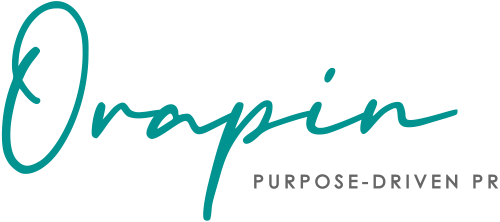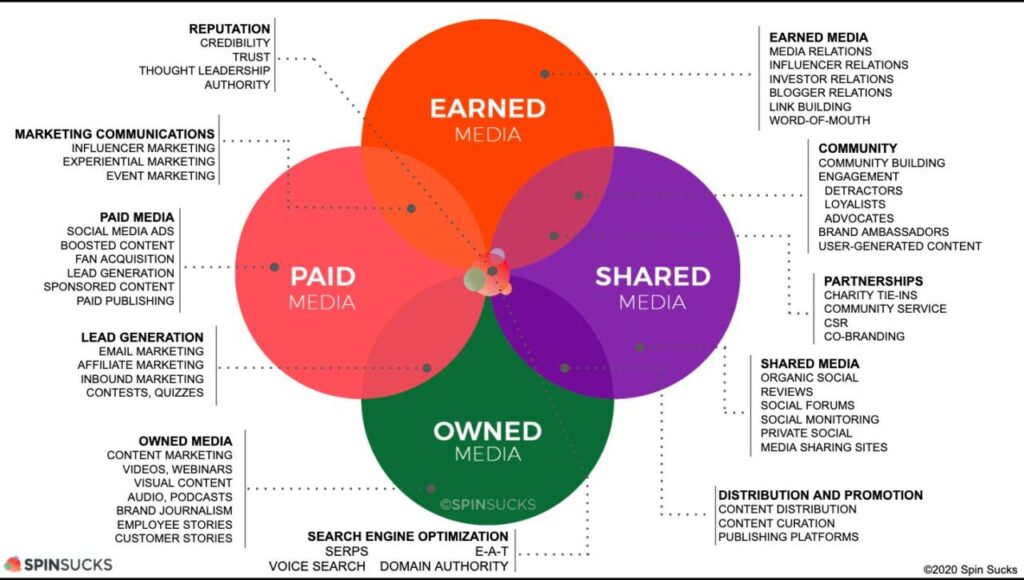
Paid. Earned. Shared. Owned. The four keys to integrated and successful PR
The fourth quarter and end of the year mean it’s time to map out strategies and plan budgets for the year to come. For purpose-driven companies and nonprofits, communications strategies should focus on amplifying the voice of the organization, connecting with key audiences, increasing awareness and visibility for their cause, and generating recognition for their work.
PR, of course, is one of the most effective ways an organization can achieve these goals and certainly should remain a focus when planning for the coming year. However, PR should not be approached in a silo. An integrated approach will get you the most bang for the buck.
As PR practitioners, we’re often only known or valued for earned media, or publicity gained through word-of-mouth, buzz, reviews, news coverage, comments, feedback, likes, mentions, shares, and various promotional efforts. However, in the modern world of communications, earned media is only a small piece of the pie when it comes to communications strategy.
To really win at the PR and communications game, organizations should look at a more holistic approach such as the “PESO Model.” The PESO model stands for Paid Media, Earned Media, Shared Media, and Owned Media, otherwise known as a PR and marketing framework built upon an integrated approach of different media types.
The PESO model was developed by Gini Dietrich, the founder, CEO, and author of Spin Sucks and host of the Spin Sucks podcast. It is perhaps best described by this nifty little visual:
Dietrich created this model as an approach to address and explain the modern media landscape. If we, as PR professionals, agree to be pigeonholed and focus on only earned media, we are effectively ignoring critical sectors of the media landscape at a detriment to our organization’s reach.
When you think about it, it really is a no-brainer. One wouldn’t do all the hard work to get a feature story on a key donor and their dedication to your nonprofit’s unique cause and then stop there. You would of course share the story on your social media channels. And then, as a smart and savvy marketer, you would probably promote those posts to really maximize the reach of that earned media win. Finally, you would repurpose the information for your own blog and likely include it in your next newsletter. Voila, the PESO model in action.
Let’s breakdown the PESO model
Paid Media
In the context of the PESO communications strategy, paid media does not refer to billboard ads, TV commercials, or newspaper classifieds. It refers to the types of media that amplify the voice of the organization. In other words, the types of media buys that help expand the reach of your earned content, owned content, and shared content.
PR traditionalists might be against integrating any type of paid media content as earned media was, at one time, the end game for PR strategy. But in today’s modern world, you must have an SEO strategy to help potential clients find your website, you must find a way for your thought leadership to stand out on very crowded social media platforms, and you must find a way to get new followers and build awareness for your work. To accomplish this feat, you have to pay.
Thus, paid media in the world of the PESO model includes sponsored posts on Facebook, Instagram, and sponsored tweets on Twitter. It includes dollars spent on lead generation and fan acquisition, Outbrain, SEO strategy, money/collateral paid to influencers and cause ambassadors, and any other dollars that may be spent towards amplifying the voice of the organization.
Though paid media comes first in the acronym, it isn’t where PR shines. That comes next in the Earned Media category. The main benefit of paid media in the context of this framework is in its predictability as dollar spends yield exact and predictable results within a target market. One could really delve down a rabbit hole in regards to this topic, so refer to the experts at Forbes if you want to learn more.
Earned Media
Earned media is the segment of the PESO model that an organization’s leaders and communications professionals are perhaps most familiar with and is likely, if you are reading this blog, the main focus of your PR strategy.
Earned media is publicity for a cause, service, message, or a thought leader. Earned media can run the gamut from traditional media hits including print, online, and broadcast, or it can be speaking engagements, podcast interviews, and byline articles. In addition to traditional media relations, earned media also includes blogger relations, influencer relations, and even investor or donor relations.
Though earned media can be unpredictable, and you relinquish control of the content once the pitch goes out, the third-party endorsement/validation that comes from an influencer mentioning their support of your cause or a media feature story is of the absolute highest value from a marketing perspective. Further, having your name or organization included on a highly ranked third-party website is gold when it comes to SEO.
Shared Media
As much as it may be the bain of our existence at times, we all live and breathe the inescapable pull of shared media, aka, social media. Shared media includes Twitter, Facebook, LinkedIn, Instagram, YouTube, TikTok, and others. All organizations should have a presence on select, relevant social media channels as the value of an extremely targeted audience who has self-selected to receive your/your organization’s message is unmatched in the advertising realm.
Once you get that earned media hit, sharing it on your social channels should be your immediate next step. It amplifies the reach of your story to the people who are most interested in hearing about it thus rallying people around your cause and increasing visibility for your good work.
Shared media is a really interesting platform as there is a high level of trust amongst audiences, even though not all news shared on social media is reliable. Benefits also include its direct and immediate access to your audience and the fact that it is cost-free (until you get to the paid advertising/boosted posts part). It is slightly unpredictable however in that once content is posted, you relinquish control over how and where users will share it, and further, the nature of the comments that might ensue below the post.
Owned Media
Last, but certainly not least, is owned media. Owned media is media generated in-house and fully controlled by your organization. Owned media includes blog posts, e-newsletters, social posts, podcasts, webinars, self-published articles, customer/client/user-generated content or reviews, and employee-generated content.
Frequently, owned media can be an afterthought. “Oh, we should probably have a blog on our website,” is then followed by “Has anyone written a blog post in the past six months?” But as Deitrich points out, owned media really should be a primary focus for organizations as it provides a foundation for the rest of the PESO strategy.
Owned media is content. Content is king. Owned media is where thought leaders can share their manifestos and their brilliant ideas. It is where organizations can outline their ideals, mission, what sets them apart and explain their special sauce. Owned media is the foundation for all other types of media, especially social media. If journalists want to vet an individual or organization before or during the process of writing a feature story, they will look to the organization or individual’s owned and social media channels. And of course, owned media makes great content for a paid media strategy.
Putting it all together
Hopefully, this deep dive on the PESO model reinforces the importance of an integrated marketing and PR strategy for the modern media landscape. As we’ve discussed, all areas are interconnected and every piece of the pie supports and leverages the others to flow into one contiguous strategy.
When creating your 2021 marketing plans, make sure you’re including each of the four media types: Paid, Earned, Shared, Owned. Remember, the PR, marketing, and advertising landscapes are no longer the siloed disciplines they were decades ago. Each is an integral part of a modern holistic communications strategy.
Photo by sheri silver on Unsplash

Diana Crawford is a seasoned public relations consultant with more than 15 years of agency, consulting, and in-house experience. She joined Orapin in 2013 and manages account services and client communications strategy development. She has worked across a variety of industries and has expertise with professional services, food/alcohol, health and wellness, lifestyle, sports, education, tech, and non-profit organizations.

